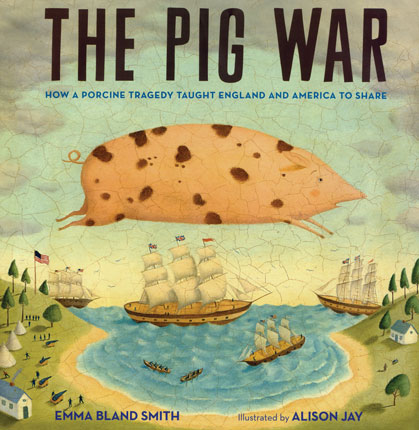| Pig war : how a porcine tragedy taught England and America to share Author: Smith, Emma Bland | ||
| Price: $6.50 | ||
Summary:
A true story of how the great nations of America and England almost went to war in 1859 over a pig-but learned to share instead.
| Illustrator: | Jay, Alison |
| Accelerated Reader Information: Interest Level: MG Reading Level: 4.50 Points: .5 Quiz: 510807 |
Reviews:
Kirkus Reviews (10/01/20)
School Library Journal (11/01/20)
Booklist (+) (11/01/20)
The Bulletin of the Center for Children's Books (+) (00/11/20)
Full Text Reviews:
School Library Journal - 11/01/2020 Gr 2–5—This true story takes place in 1859 in San Juan, an island located off the coast of the Pacific Northwest. An argument over a single pig pitted neighbor against neighbor and set into motion a series of events that led to a military standoff between England and America. Smith's narrative dives into a strange and humorous slice of history that nearly started another war between the two countries. American settler Lyman Cutlar was annoyed to find a pig in his potato patch. Cutlar killed the pig, which belonged to Charles Griffin, who was British. Cutlar offered to pay for the pig, but Griffin wanted more money than Cutlar was willing to pay. Their argument eventually resulted in the deployment of both the Queen's military and American battleships. This porcine altercation is detailed with lofty humor that makes for an intriguing and endearing read, though some older elementary readers may find the story's moralistic conclusion condescending. Jay's distinctive illustrations, rendered in alkyd paint with crackle glaze varnish, lend an old-timey feel and playful whimsy that matches the tone of the text. The book centers the perspective of white colonizers and early America, and the text only mentions stolen Native land as an afterthought in the back matter. The author's note states, "Various countries had claimed ownership of this area over the centuries (stubbornly ignoring the fact that the indigenous Coast Salish and Northwest Coast peoples had lived there much longer)." VERDICT The book's humor and whimsy provide an interesting narrative nonfiction read for elementary classrooms, but the niche subject and erasure of Native history make it suitable only for additional purchase.—Allison Staley, Lake Oswego P.L., OR - Copyright 2020 Publishers Weekly, Library Journal and/or School Library Journal used with permission.



